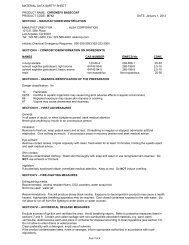MSDS - Alsa Corp
MSDS - Alsa Corp
MSDS - Alsa Corp
Create successful ePaper yourself
Turn your PDF publications into a flip-book with our unique Google optimized e-Paper software.
MATERIAL SAFETY DATA SHEET<br />
Clean preferably with a detergent; avoid use of solvents.<br />
If the product contaminates lakes, rivers or sewages, inform appropriate authorities in accordance with local regulations.<br />
SECTION VII – HANDLING AND STORAGE<br />
Handling:<br />
Vapors are heavier than air and may spread along floors. Vapors may form explosive mixtures with air. Prevent the creation of<br />
flammable or explosive concentrations of vapor in air and avoid vapor concentration higher than the occupational exposure limits.<br />
In addition the product should only be used in areas from which all naked lights and other sources of ignition have been excluded.<br />
Electrical equipment should be protected to the appropriate standard.<br />
Preparation may charge electrostatically: always use earthing leads when transferring from one container to another. Operators should<br />
wear antistatic footwear and clothing and floors should be of the conducting type. Keep container tightly closed. Isolate from sources<br />
of heat, sparks and open flame. No sparking tools should be used.<br />
Avoid skin and eye contact. Avoid inhalation of dust, particulates and spray mist arising from the application of this preparation.<br />
Avoid inhalation of dust from sanding.<br />
Smoking, eating and drinking should be prohibited in application area.<br />
For personal protection see Section 8.<br />
Never use pressure to empty: container is not a pressure vessel. Always keep in containers of same material as the original one.<br />
Comply with the health and safety at work laws.<br />
Storage:<br />
Although the storage and use of this product is not subject to specific statutory requirements, observation of the principles of the<br />
Highly Flammable Liquids and Liquefied Petroleum Gases Regulations as appropriate will be seen as good industrial practice in<br />
meeting the general duties of the Health and Safety at Work Act.<br />
Observe label precautions. Store between 10 and 25°C in a dry, well ventilated place away from sources of heat and direct sunlight.<br />
Keep away from sources of ignition. Keep away from oxidizing agents, from strongly alkaline and strongly acid materials.<br />
No smoking. Prevent unauthorized access. Containers which are opened must be carefully resealed and kept upright to prevent<br />
leakage.<br />
SECTION VIII – EXPOSURE CONTROLS/PERSONAL PROTECTION<br />
Engineering Measures<br />
Provide adequate ventilation. Where reasonably practicable this should be achieved by the use of local exhaust ventilation and good<br />
general extraction. If these are not sufficient to maintain concentrations of particulates and solvent vapor below the OEL, suitable<br />
respiratory must be worn.<br />
Exposure Limits<br />
Occupational exposure limit for :<br />
Names CAS Number EINECS-No. STEL LTEL<br />
Isopropyl alcohol 99% (IPA) 67-63-0 200-661-7 500ppm 400ppm<br />
Acetone 67-64-1 200-662-2 1000ppm 750ppm<br />
N-Butyl Acetate 123-86-4 204-658-1 200ppm 150ppm<br />
Aluminum Powder 7429-90-5 231-072-3 NE 10mg/m 3 (dust)<br />
Solvent Naphtha (petroleum) 64742-95-6 265-199-0 100ppm 25ppm<br />
Light aromatic<br />
Personal Protection<br />
Respiratory protection:<br />
If workers are exposed to concentrations above the exposure limit they must use appropriate certified respirators.<br />
Hand protection:<br />
For prolonged or repeated handling, use barrier creams, as they may help to protect the exposed areas of the skin. They should<br />
however not be applied once exposure has occurred.<br />
Page 2 of 2












